Wako Chemicals U.S.A. is a wholly-owned subsidiary of FujiFilm. The facility, located in Richmond, Va., specializes in production of antibodies, enzymes, molecular biology, and bio and organic chemicals.
During a $35M plant expansion between 2017 and 2018, the facility’s primary R-22 process cooling chiller system was replaced and upgraded. Before the expansion, chemical production processes within the plant required a nominal 67.5 tons of cooling from a 5°F, 50 percent ethylene glycol solution with occasional higher peak loading. One goal of the plant expansion was to increase process cooling capacity sufficient to provide a level of redundancy should the source require service.
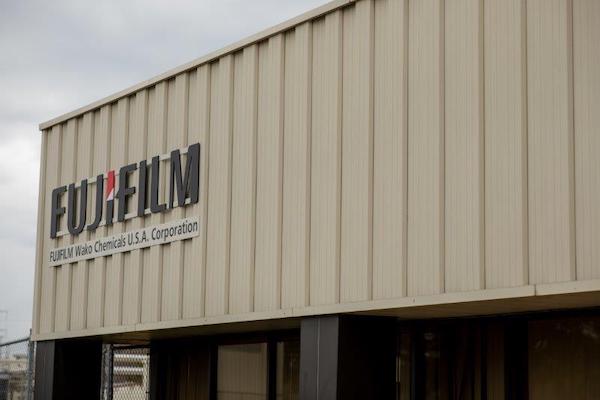
“We needed to increase cooling capacity and provide a level of redundancy,” said Daniel Frye, plant purchasing supervisor/business operations. “In addition to that, we needed extremely stable cooling capacity.”
Cooling capacity for the main process loop was originally provided by an R-22 chiller system. During the project’s initial design process, the specifications called for an in-kind replacement, to include larger R-404A HFC chillers, since R-22 has been phased out due to its high Global Warming Potential (GWP).
“I received a request for a quote from Wako’s consulting engineer, Richard Owen, Sr. processing engineer at Advanced Process Systems,” said Chris Newman, partner at Midatlantic Refrigeration. For 25 years, the rep firm has focused chiefly on industrial refrigeration.
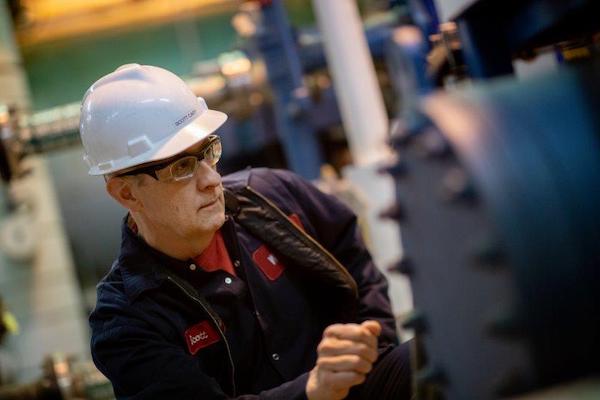
Scott Cary, plant manager at Wako.
“Wako is a longtime client of Advanced Process Systems, and Owen was an integral part of the entire plant expansion. His work wasn’t limited to the process loop,” said Newman. For nearly two decades, Advanced Process Systems has served clients around the globe, providing manufacture of API (active pharmaceutical ingredient), specialty chemical and biofuel engineering services.
“Owen originally sought replacement Freon equipment, but we saw an opportunity to specify a natural refrigerant,” Newman continued. “Given the need for 5°F process fluid temperatures, we considered the possibility of installing an ammonia-based system, even though this project was considering commercial Freon equipment, not industrial. Owen was instrumental in performing the original evaluation for the ammonia system vs. a R-404A synthetic refrigerant system. Once the evaluation was complete, it was the clear advantages of the Evapcold LCR-C low charge ammonia chiller that became evident.”
Low Charge Packaged Ammonia Systems
Midatlantic Refrigeration represents a number of different manufacturers who supply components for stick-built, field-erected ammonia systems and complete, low-charge packaged ammonia chiller systems. Newman specifies one or the other based on the application, but for Wako’s needs, he gravitated toward an Evapcold LCR-C low charge packaged system made by EVAPCO.
The Evapcold LCR-C chiller product line includes over 200 models of self-contained ammonia chillers with available capacities between 20 TR to 400 TR, with the ability to provide fluid temperatures between 5°F to 50°F. Each unit is completely piped, wired and insulated for plug-and-play installation, including starters and single-point 460V electrical connection. Variable screw compressors provide efficient capacity control and part-load operation. This provides a packaged solution and single-source responsibility in design, performance and operation.
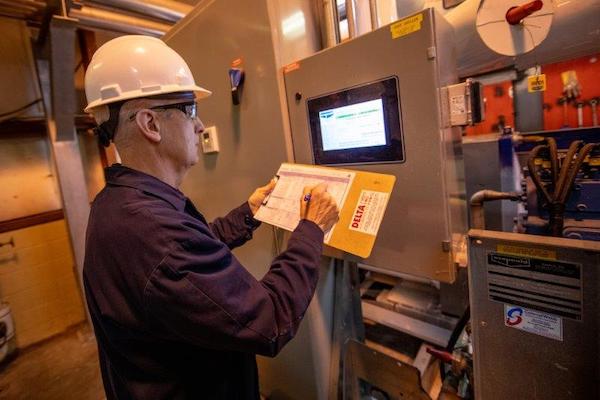
Scott Cary checks the operation of the ammonia chiller system while under load.
These packaged systems offer numerous benefits over field-erected ammonia systems and Freon chiller packages of similar capacity, including lower energy consumption, especially in low temperature glycol applications like that at Wako. In addition, they are available with several optional accessories such as the fluid pumps mounted on the package, a waste heat recovery system, outdoor enclosure package and multiple serviceability options.
Contrary to Freon, ammonia has a 0 GWP (global warming potential) and 0 ODP (ozone depletion potential). The natural refrigerant is future-proof when compared to Freon systems that are gradually being phased across the globe like what just occurred with R-22.
Packaged, low charge ammonia systems typically reduce regulatory burden, at a time when regulations are increasing. Field-assembled ammonia systems frequently require 20 to 30 pounds of ammonia per ton of capacity, while the Evapcold LCR-C requires just one pound of ammonia per ton of refrigeration, on average across the product line.
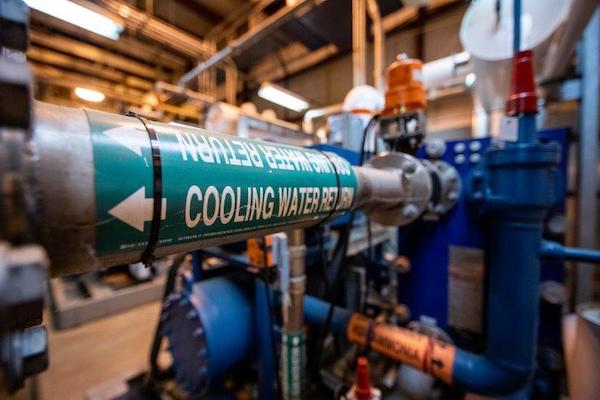
The ammonia system’s cooling tower can provide 406 GPM of recirculated condenser water to the chillers, with a 10°F ΔT.
Energy savings over freon or HFC chiller systems is achieved in several ways. First, ammonia has a much higher isentropic efficiency for the compression process, second the Evapcold unit utilizes screw compressors, which are very efficient in themselves, and third VFD’s are standard on the Evapcold screw compressor(s) and provide great efficiency at part-load operation as well.
“The packaged ammonia system was specified in place of a freon or HFC system for its better industrial design and better energy efficiency” said Owen.
After discussing the project at length with Owen, Newman sent the original specification to EVAPCO, expecting that the company’s Evapcold LCR-C ammonia chillers might present the perfect solution for the needs at Wako Chemical.
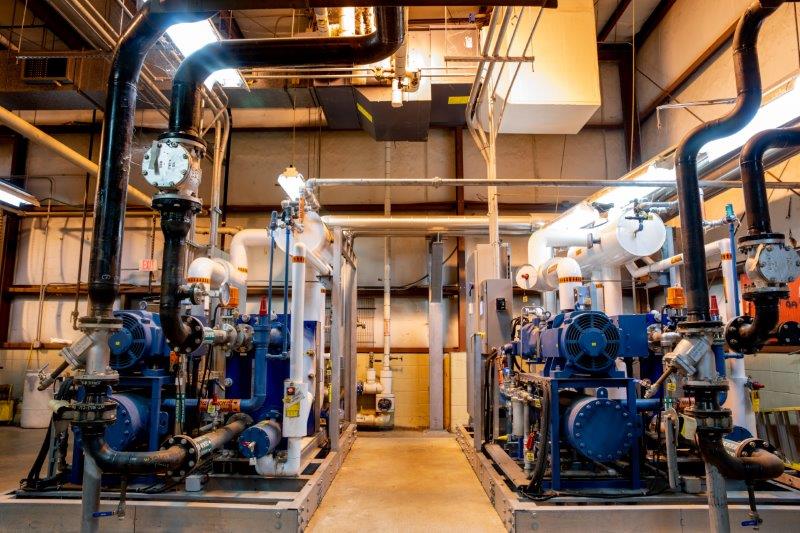
The two 67.5-ton Evapcold LCR-C ammonia chiller packages are installed in a mechanical building separate from the facility’s production space.
Discussions with EVAPCO resulted in a new submittal for two, 67.5-ton Evapcold LCR-C ammonia chillers. The revised specification matched the chilled glycol conditions from the original but was revised with ammonia as the refrigerant. Owen and Newman presented the design to Frye, and Scott Cary, plant manager at Wako.
“When we took the new submittal package to the customer, I expected some hesitation about switching from Freon to ammonia due to lack of familiarity. They explained that there were already several smaller ammonia systems in various places throughout the plant, and they were familiar with its advantages, including the energy efficiency of ammonia at such low operating temperatures. At low temperatures, Freon systems often struggle. Ammonia equipment is meant to remain below freezing; exactly what Wako needed.”
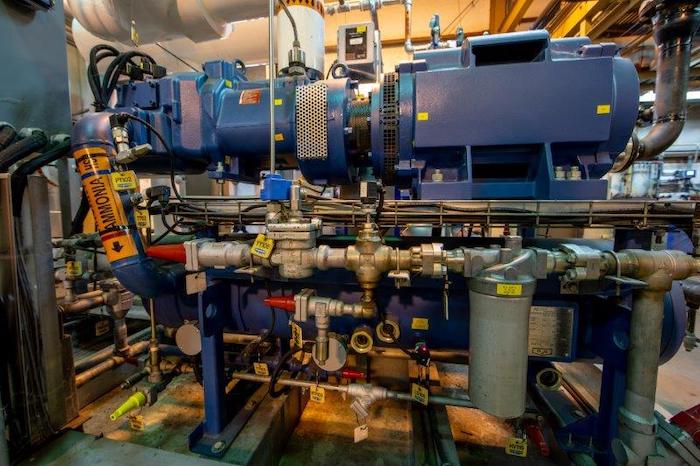
The 67.5-ton Evapcold LCR-C ammonia chiller packages required minimal space, each measuring 12’ 11 ¾” L x 6’ 8” W.
Another strength for the packaged LCR-C chiller system was that Evapco provides comprehensive documentation with each unit. This includes complete operating and maintenance procedures, training materials, a hazard review, all unit submittals and drawings, rigging manuals, detailed information on electrical panels and controls, as well as site-specific calculations for relief valves and ventilation.
“The solution we provided with the LCR chiller was a pre-fabricated, pre-engineered, factory-tested product from a single source,” said Newman. “We couldn’t have accomplished that with a Freon system, let alone a field-erected ammonia system. Wako took total acceptance of the new specification, and the units were shipped in April of 2018.”
Rapid Installation
With dimensions of 12’ 11 ¾” L x 6’ 8” W, the Evapcold chiller packages were installed in an existing utility building not far from the processing plant, where the smaller R-22 chillers had been located, even though the ammonia chillers have more capacity than the R-22 chillers. Keeping the self-contained units outside of the plant saves space within the main facility and keeps all service and maintenance procedures separated from processing or refrigerated spaces. It also eliminates ammonia from the main facility.
“The chiller systems were piped to two existing pump skids and hot-well cold-well tanks without requiring much rework,” said Andy Brogan, sales engineer at ColonialWebb, a full-service industrial firm with branches providing construction, building service, industrial refrigeration, manufacturing and building automation services from seven locations throughout the mid-Atlantic. “One skid for the process glycol loop side and one for the condenser fluid loop, leading to an open-loop cooling tower.”
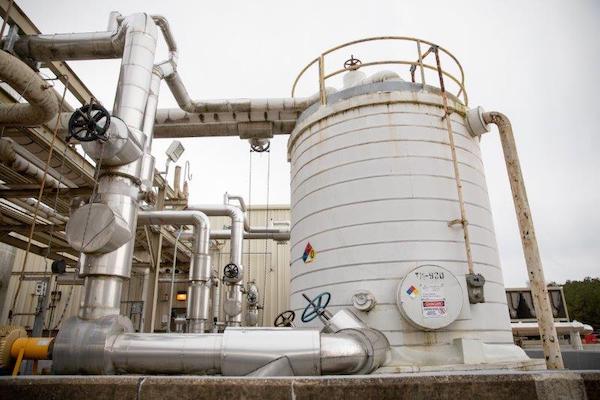
The chiller systems were piped to two existing pump skids and hot-well cold-well tanks.
The cooling tower can provide 406 GPM of recirculated condenser water to the chillers. Condenser water enters the cooling tower at 95°F and returns to the chillers at 85°F.
Glycol solution leaves the packaged chillers at 5°F, and returns to the chillers at 15°F with a -1°F compressor suction temperature for a total of 135 TR’s. Maximum flowrate of solution through each chiller 194.2 GM, providing a total flowrate of 388.4 GPM to the process loop heat exchanger.
The utility building features an independent relief header and four ammonia detectors that alarm an ammonia leak over 100 ppm.
“I conducted start-up and commissioning of the chillers,” said Brogan. “This was the first Evapcold system I’ve worked on. I wish more plants would go this direction for their refrigeration needs. These units are user friendly, easily maintained, and based on the quality of construction, they look like they’ll last a long time. Being a critically charged, packaged system, there aren’t an abundance of components scattered throughout the facility. Everything is localized and easier to work on, which mitigates the problems typical to ammonia systems.”
Brogan charged each unit with 80 pounds of ammonia, or 160 pounds for the whole system. Given the total cooling capacity of 135 tons, he was surprised to find that the system only required 1.18 pounds of ammonia per ton and was able to complete the charge with a single 400 pound cylinder.
Immediate Use
Because Wako Chemical is a full production facility and there was no backup cooling system for the old R-22 chiller system, the new ammonia system was put into service immediately. This occurred in August of 2018, and the system performed flawlessly.
The two identical units are almost entirely redundant. Brogan explained that one system runs 24-7, while the second may come on for an hour per day at the height of the summer. He manually switches lead-lag positions monthly to keep the equipment lubricated and to balance runtime hours.
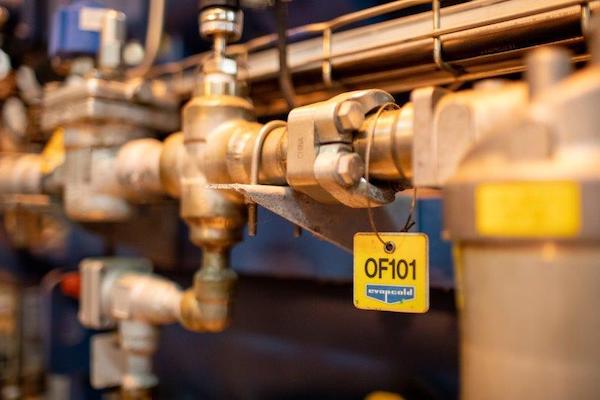
Despite a total nominal capacity of 135 tons, the Evapcold LCR-C ammonia chiller packages only required an ammonia charge of 1.18 pounds.
The LCR-C units specified for the Wako project did not include a heat recovery system, which is an optional accessory that is often included on ammonia chiller installations. In this type of heat recovery system, waste heat can be salvaged from the Evapcold units and used in a variety of ways, like underfloor warming in cold storage spaces, process defrost, snowmelt, etc. It was omitted from the Wako design because there wasn’t a need for heat in this application.
“Wako managers have been more than satisfied with the new system,” said Brogan. “The only change we’ve made was how the system is monitored. Initially, we monitored suction pressure. Now we’re monitoring the glycol loop temperature instead.”
Process Improvements
“In addition to better cooling and easier maintenance, we’re no longer dependent on R-22 for the main process loop,” said Frye. An ammonia system like this one has an inherent advantage as well.” The COP of the new Evapcold low charge NH3 chillers is 2.49 at full load and the 5°F process temperature, while the COP of a new alternate R-404A commercial chiller is 2.14; or an 18 percent advantage for the low charge ammonia system. The energy advantage improves at part load as well due to the variable speed driven screw compressors, all of which can lead to significant operational savings.
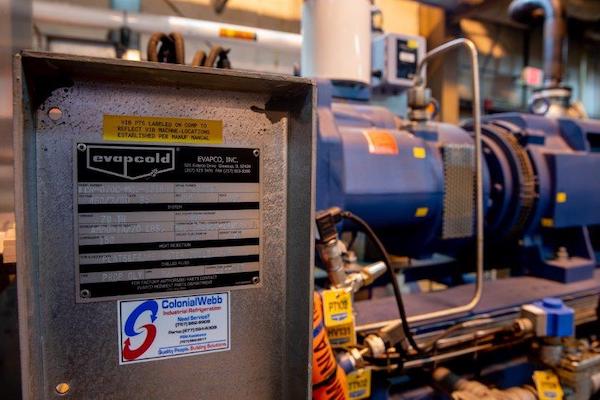
Colonial Webb, a full-service industrial firm with seven locations throughout the mid-Atlantic, installed the entire ammonia chiller system.
After more than two years in service, there has only been one issue; a glycol valve became inoperable and needed to be replaced. Packaged systems like these allow Evapcold to provide lower life-cycle costs due to decreased energy usage, lower refrigerant costs, improved compliance, clearly defined operation and preventative maintenance procedures, and industrial grade manufacturing and components.
“This was the easiest start-up I’ve witnessed in 30 years,” said Newman. “I attribute that to the fact that with a field-erected system, you’re individually sourcing and commissioning all system components. This entire system is pre-engineered, factory-built and factory tested. I don’t think there’s a more reliable system available, or one that’s as easy to implement.”



